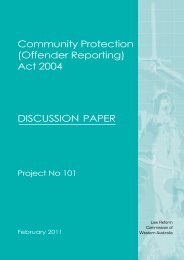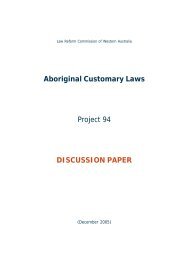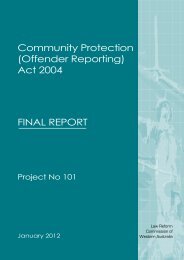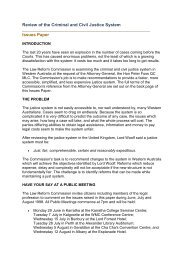Discussion Paper - Law Reform Commission of Western Australia
Discussion Paper - Law Reform Commission of Western Australia
Discussion Paper - Law Reform Commission of Western Australia
You also want an ePaper? Increase the reach of your titles
YUMPU automatically turns print PDFs into web optimized ePapers that Google loves.
4.43 The relevant legislative provision in relation to settlement and discontinuance<br />
is s 33V <strong>of</strong> the Federal Court <strong>of</strong> <strong>Australia</strong> Act 1976 (Cth), which reads as follows:<br />
33V Settlement and discontinuance—representative proceeding<br />
(1) A representative proceeding may not be settled or discontinued without the<br />
approval <strong>of</strong> the Court.<br />
(2) If the Court gives such an approval, it may make such orders as are just with<br />
respect to the distribution <strong>of</strong> any money paid under a settlement or paid into the<br />
Court.<br />
4.44 The nature and extent <strong>of</strong> settlement <strong>of</strong> representative actions is covered in<br />
substantial detail by many commentators. 34 As Cashman has indicated:<br />
[C]lass action settlements raise unique and complex issues for a number <strong>of</strong> reasons.<br />
Unlike with traditional settlements in conventional litigation, group members in<br />
class actions who will be bound by the settlement agreement if it is approved by the<br />
Court, will usually not have participated in the settlement negotiations and not have<br />
consented to, or <strong>of</strong>ten be aware <strong>of</strong>, the proposed terms <strong>of</strong> settlement. 35<br />
4.45 The present legislative provision contains no statutory guidance or criteria<br />
that a court should take into account when considering whether to approve the<br />
settlement or discontinuance <strong>of</strong> an action.<br />
4.46 Another issue that arises from the brevity <strong>of</strong> the legislative provision relating<br />
to settlements is the extent to which persons other than the lawyers for the group<br />
members ought to communicate with them about resolution <strong>of</strong> a group member’s<br />
claim. Clark and Harris argue that ‘[f]rom a respondent’s perspective, direct<br />
communication with unrepresented group members is consistent with a desire for<br />
the early resolution <strong>of</strong> claims’. 36 The contrary view is that if reform is contemplated<br />
in this area, there should be clear guidelines requiring all settlement communications<br />
to take place only through the solicitors instructed to represent the class. 37<br />
4.47 The <strong>Commission</strong> considers that it is desirable to achieve as much uniformity<br />
as possible between jurisdictions in relation to the way in which settlements <strong>of</strong><br />
representative action proceedings are effected. This will reduce forum shopping<br />
and provide benefits in terms <strong>of</strong> consistency <strong>of</strong> judicial approach. Having regard<br />
to the similarity <strong>of</strong> the approach in the jurisdictions with legislative schemes, it is<br />
the view <strong>of</strong> the <strong>Commission</strong> that any framework adopted by <strong>Western</strong> <strong>Australia</strong> in<br />
relation to the settlement <strong>of</strong> claims should be substantially based on the provisions<br />
<strong>of</strong> Part IVA.<br />
34. See, eg, Murphy B & Cameron C, ‘Access to Justice and the Evolution <strong>of</strong> Class Action Litigation’ (2006) 30 Melbourne University <strong>Law</strong><br />
Review 399, 427–31; Grave & Adams, ibid, ch 13; Cashman P, Class Action <strong>Law</strong> and Practice (Sydney: Federation Press, 2007) ch 6.<br />
35. Cashman, ibid. See also Morabito V, ‘An <strong>Australia</strong>n Perspective on Class Action Settlements’ (2006) 69 Modern <strong>Law</strong> Review 347.<br />
36. Clark S & Harris C, ‘The Push to <strong>Reform</strong> Class Action Procedure in <strong>Australia</strong> : Evolution or Revolution’ (2008) 32 Melbourne University <strong>Law</strong><br />
Review 775, 819.<br />
37. Murphy B & Cameron C, ‘Access to Justice and the Evolution <strong>of</strong> Class Action Litigation’ (2006) 30 Melbourne University <strong>Law</strong> Review 399,<br />
431.<br />
Chapter 4: Comparison <strong>of</strong> Models 51








